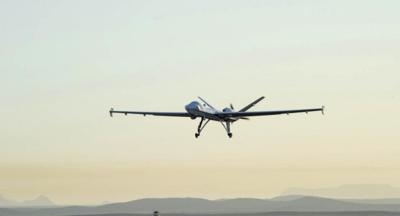Flight Represented 'A Capstone Of All The Phase One Efforts That Were Done' NASA Official Says
The June flight of a large unmanned aircraft in the National Airspace System without the use of a chase plane took “thousands of hours” and a tightly integrated detect and avoid system, NASA and industry officials said last week.

“This historic flight moves the United States one step closer to normalizing unmanned aircraft operations across the U.S.,” NASA said in a press release announcing a press teleconference held Thursday afternoon to discuss the historic flight.
On June 12, NASA and partners General Atomics Aeronautical Systems (GA-ASI), Honeywell and the FAA conducted the demonstration, a 2.5-hour flight not far from Los Angeles. NASA and its partners had been working on detect and avoid capability since 2011, which included three major flight test campaigns in controlled airspace.
The June 12 represented “a capstone of all the phase one efforts that were done,” NASA’s Sam Kim, the technical lead for NASA’s UAS integration effort, said in the teleconference.
The aircraft was a GA-ASI-built MQ-9 Predator, which NASA has operated for years as the Ikhana, which is based at Armstrong Flight Research Center in Edwards, California. Ikhana is 36 feet long and has a wingspan of 66 feet, so it’s larger than many entry-level general aviation aircraft. It took off from Armstrong and exited restricted airspace soon after. It flew into Class A airspace, at about 20,000 feet, later moved into Class E airspace at around 10,000 feet and then Class D airspace at 5,000 feet.
It carried an airborne radar developed by GA-ASI; a Honeywell-developed detect-and-avoid and Traffic Alert and Collision Avoidance System (TCAS) II tracking system; Automatic Dependent Surveillance-Broadcast (ADS-B) in and out systems; and a pilot interface with a “conflict prediction” system, according to GA-ASI’s Fabrice Kunzi, the chief engineer for the DAA system. This allowed it to combine collision avoidance with a remain-well-clear function, Kunzi said, and was “more capable than a pilot’s ability to see other aircraft in many ways.”
In announcing the flight earlier in June, GA-ASI said the Ikhana demonstration “served as the basis for verification and validation of RTCA DO-365 and DO-366 technical standards for DAA,” which were published by RTCA in May 2017.
GA-ASI has been developing the DAA system with “internal funding for inclusion on all its aircraft.” Particularly, the MQ-9B SkyGuardian UAS is provisioned to include the DAA system as a customer option, and GA-ASI’s MQ-25 offering also includes the opportunity for the U.S. Navy to incorporate DAA.
Kim said industry could now take the DAA standards and the minimum operational performance standards and use them to request their own flights in the National Airspace System. He said NASA and its partners will continue to work on integration efforts for medium-sized and small UAS systems, which will require miniaturized components.
“Ultimately, the goal would be for routine access, or file and fly, where COAs aren’t needed,” Kim said, referring to certificates of authorization from the FAA.
(Source: AUVSI report. Image provided by NASA)
 NTSB Prelim: Piper PA-23
NTSB Prelim: Piper PA-23 ANN FAQ: Submit a News Story!
ANN FAQ: Submit a News Story! Classic Aero-TV: One Mans Vietnam
Classic Aero-TV: One Mans Vietnam ANN's Daily Aero-Linx (07.03.25)
ANN's Daily Aero-Linx (07.03.25) ANN's Daily Aero-Term (07.03.25): High Speed Taxiway
ANN's Daily Aero-Term (07.03.25): High Speed Taxiway



